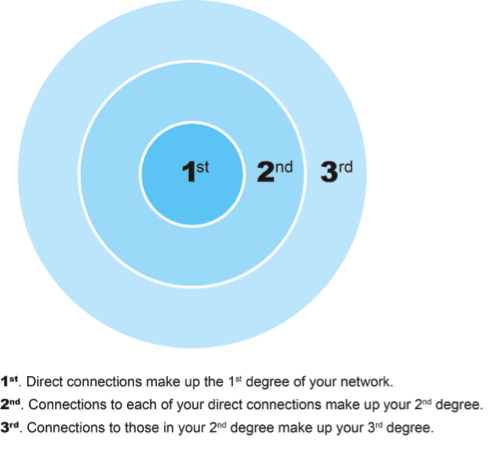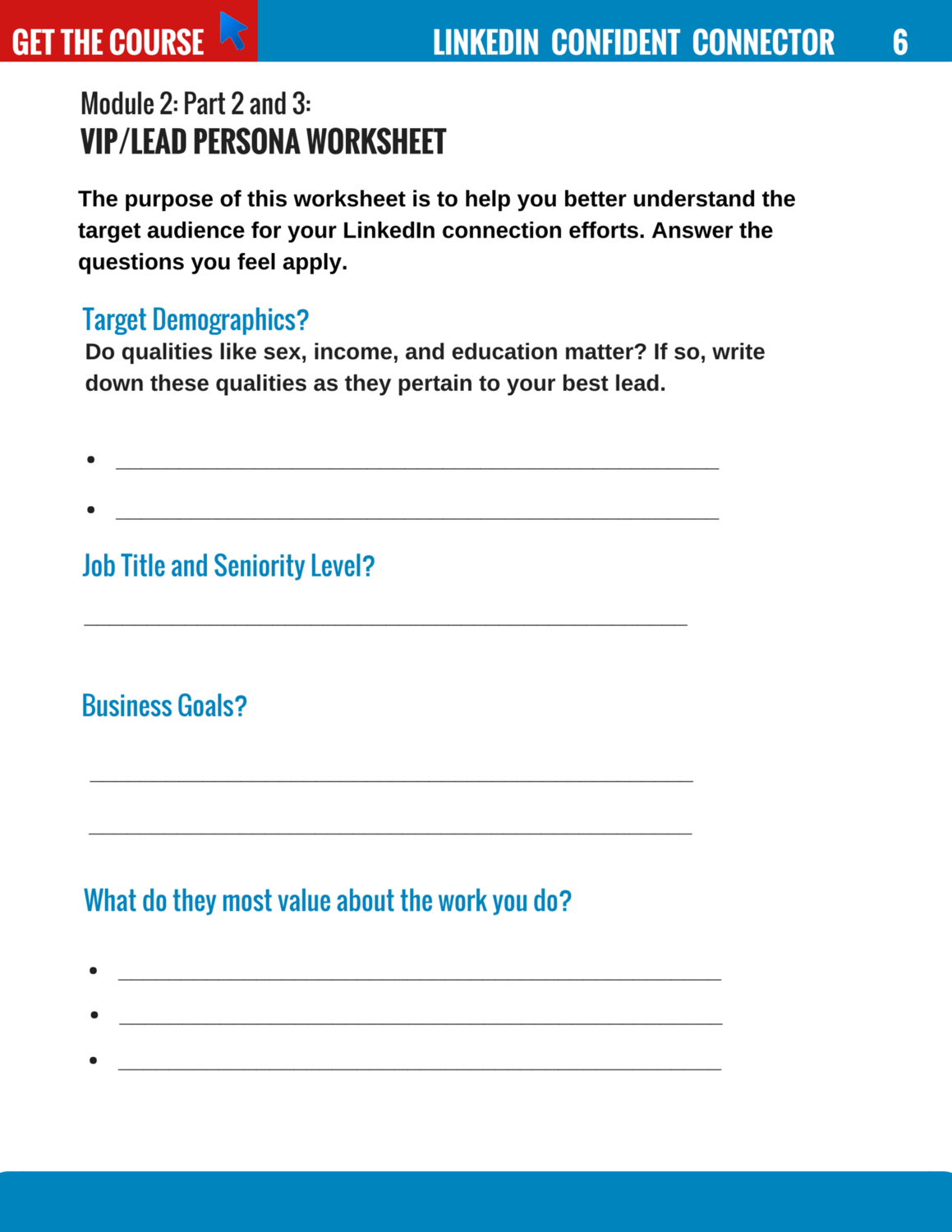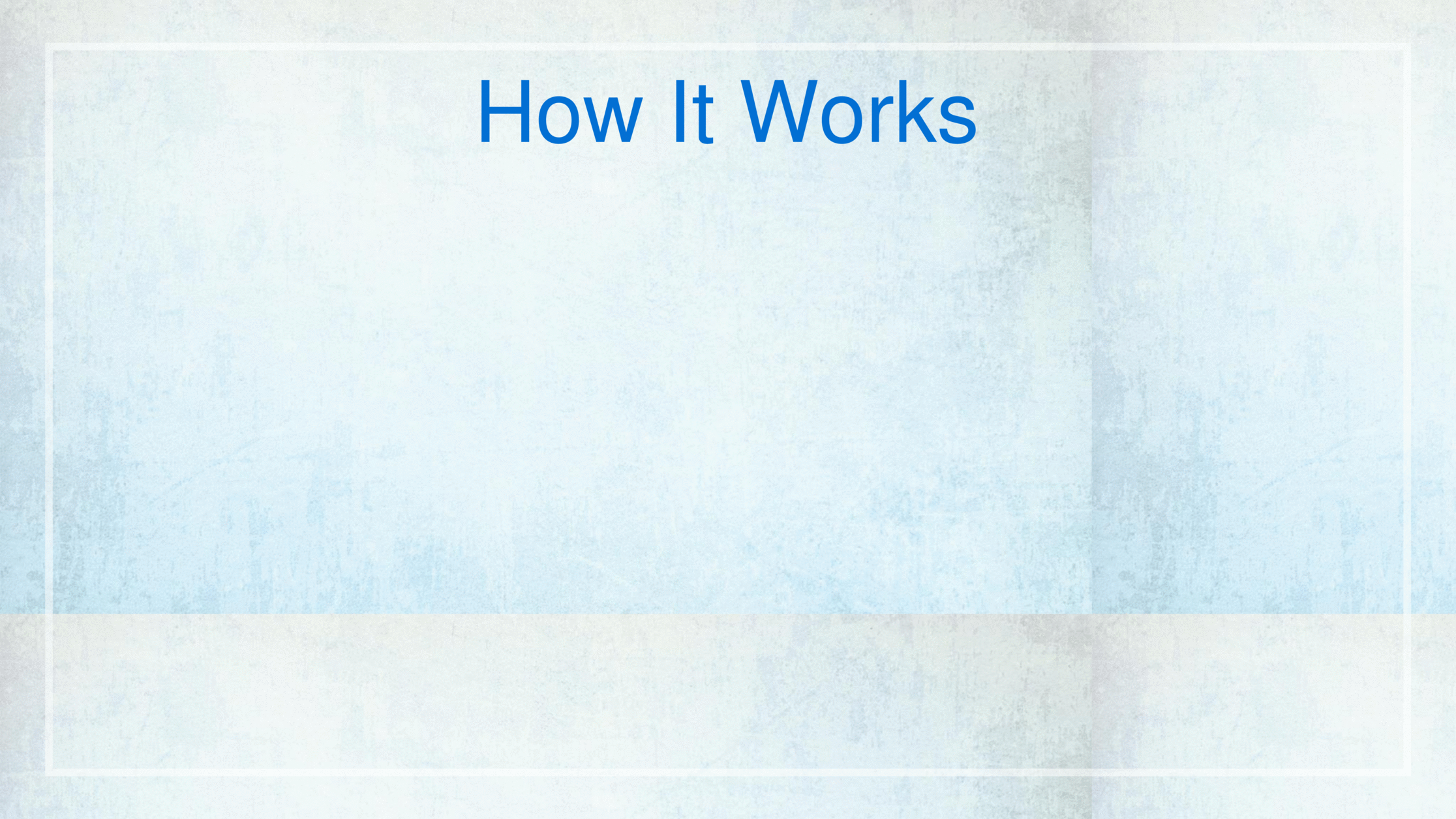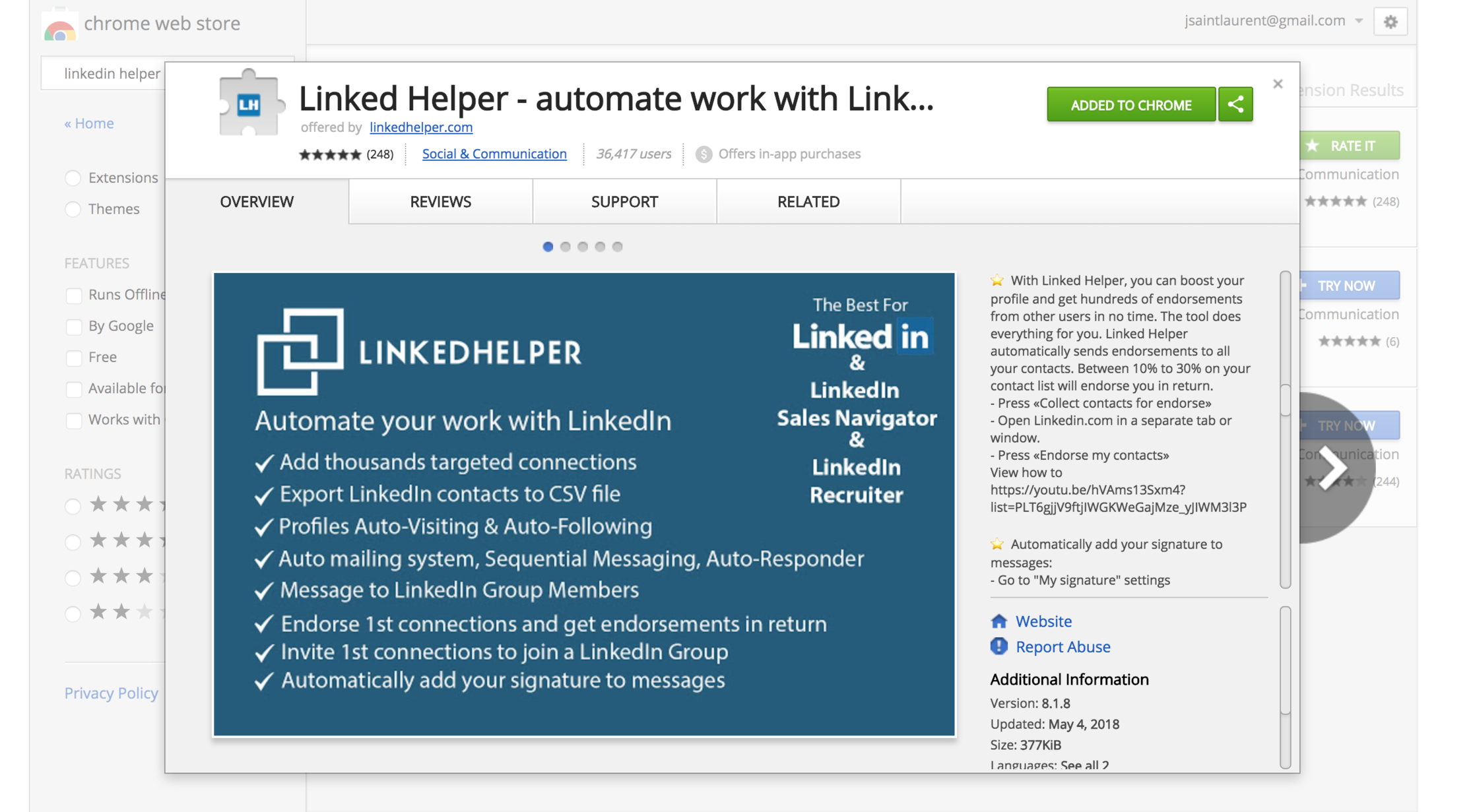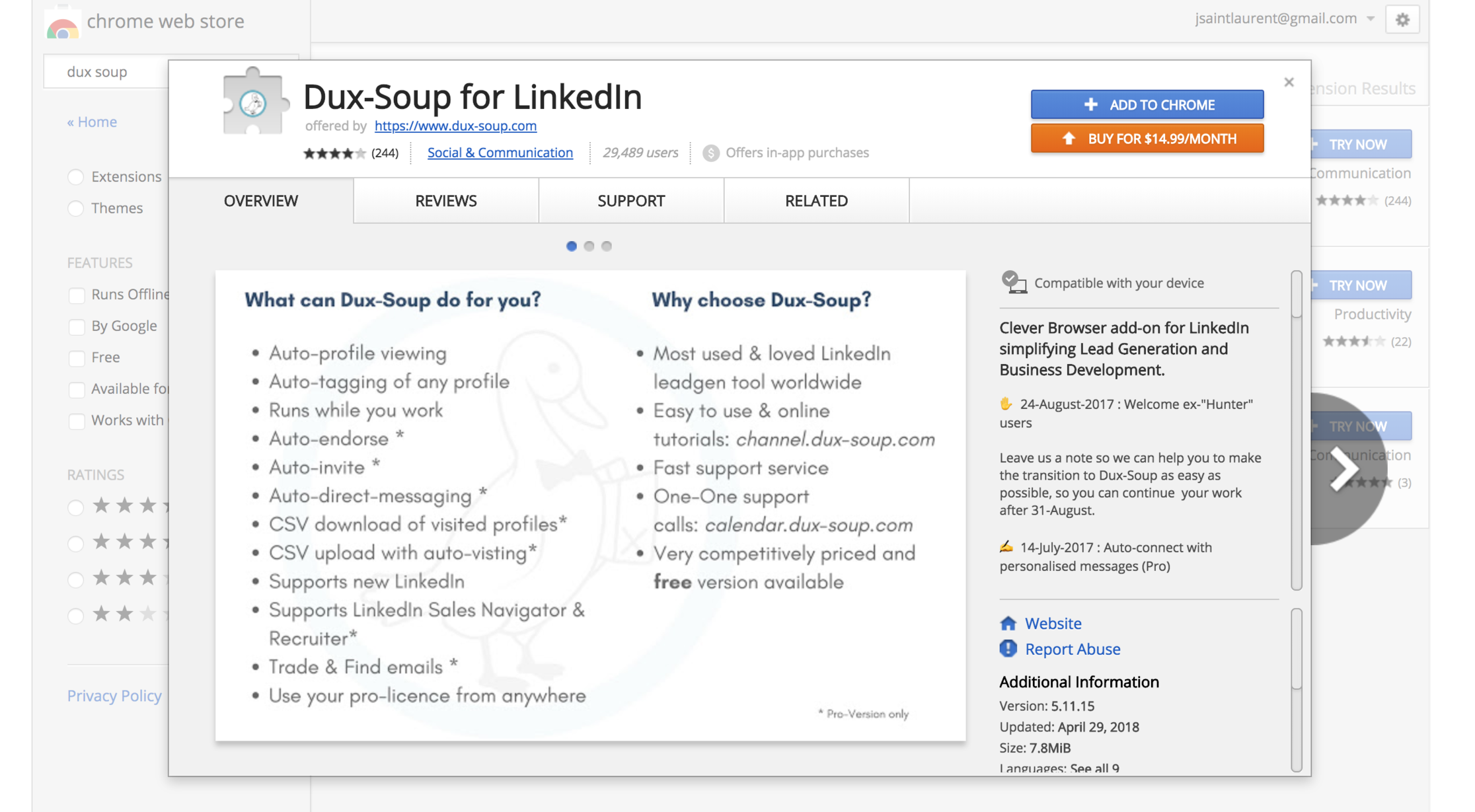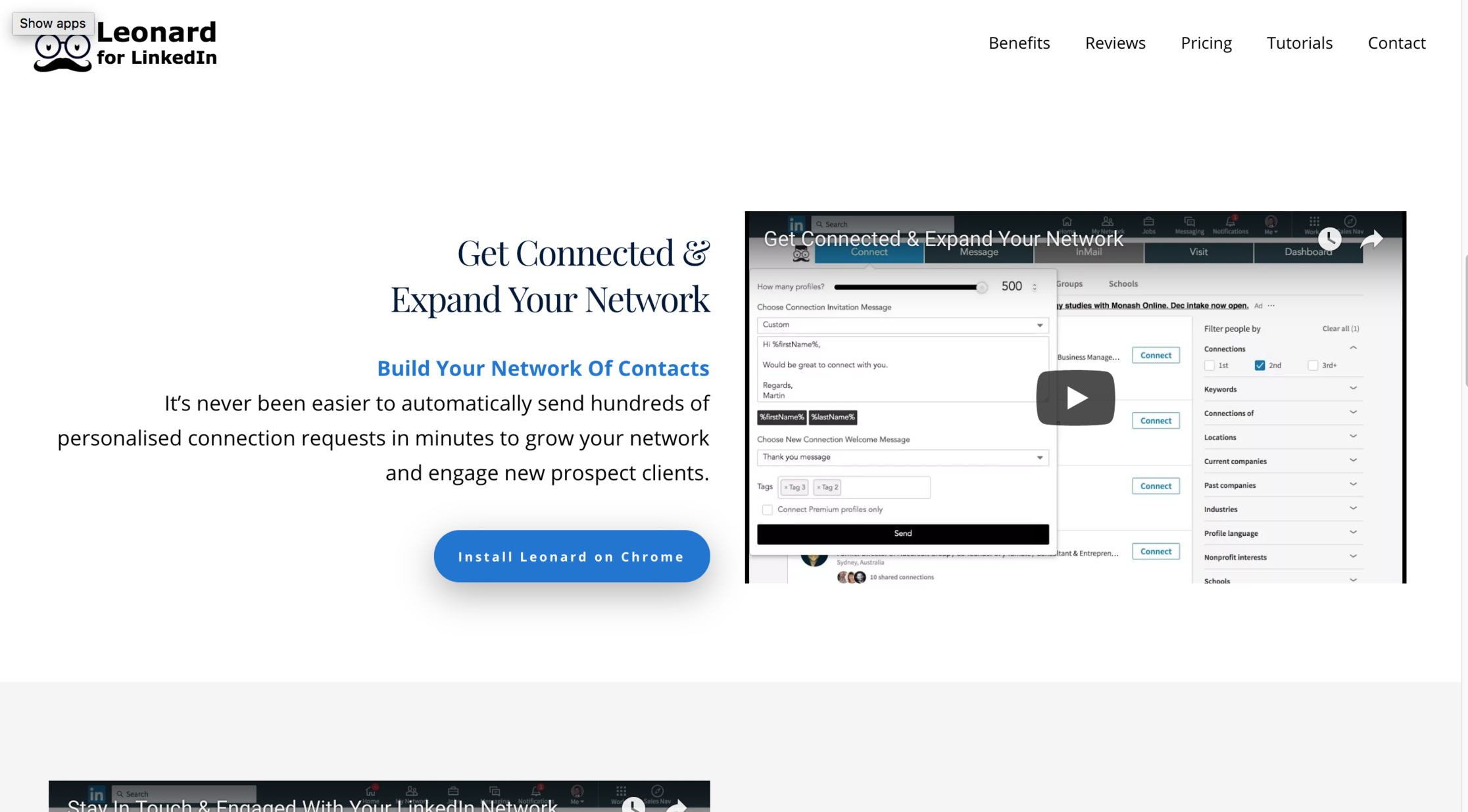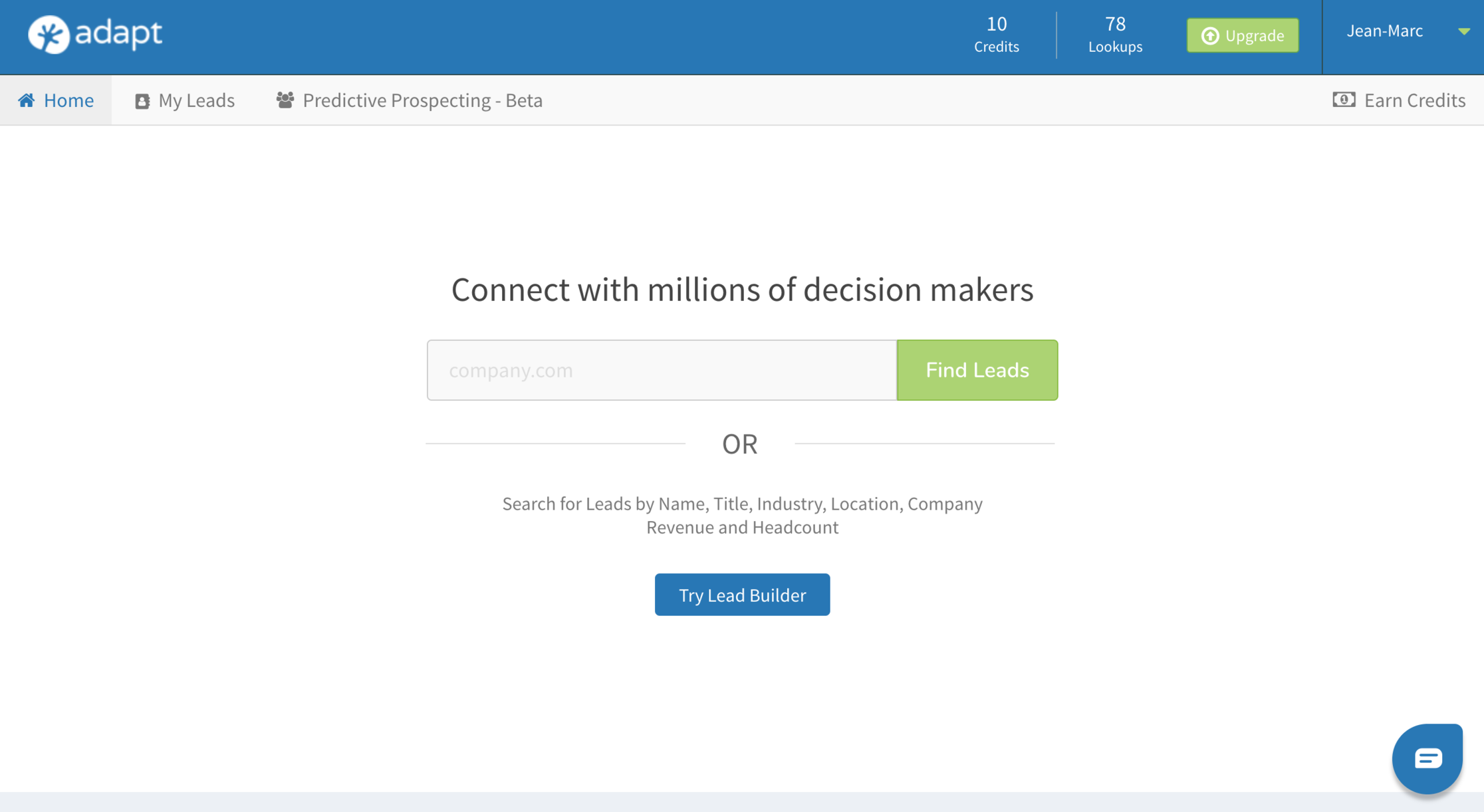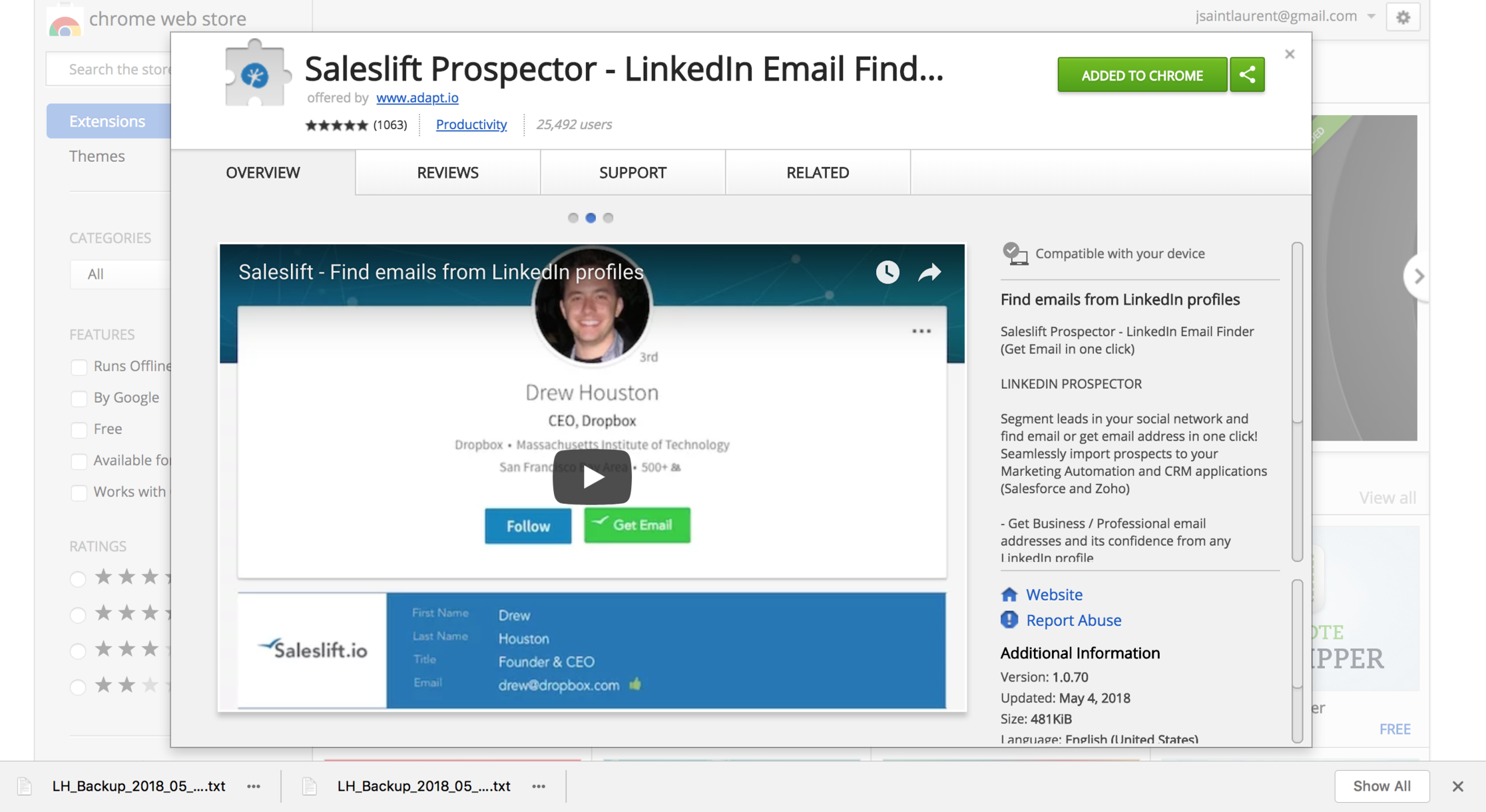
by Jean-Marc Saint Laurent | Jun 14, 2018 | LinkedIn Lead Generation, Using LinkedIn for Sales
LinkedIn Leads and Social Selling: How We Got Here
The LinkedIn Social Selling phenomenon is yet another recent development in the changing world of sales, especially business to business sales.
In the past, the idea was that salespeople had the power, so if you wanted to get widget from XYZ incorporated, you would have to find XYZ Incorporated’s information in the phone book or in their advertisement right in the newspaper, and then you would reach out to them.
Once you reached out to them, then they would have a salesperson get back to you. Remember this? You just might as well have been talking to an answering machine because the big crux of this whole predicament was that buyers did not have the power (a.k.a the information). Make sense?
As the proliferation of technology made the idea of information for everyone a cliche, the power dynamic shifted from sellers to buyers. While this isn’t to say sellers are powerless, they just don’t have the hypnotist’s sway over a captive credit card-holding audience a la Thighmaster Gold.
If you’re selling anything these days, you how people love to talk about all of their options!
So doing the whole LinkedIn leads thing represents just another point in this critical shift in sales and the general sales environment.
As people come to terms with this shift, they’ve reacted in a few different ways.
One of the ways they’ve interacted with this shift in the sales environment is to try to shift the flow of selling. An example of this is inbound marketing versus outbound marketing. Inbound marketing is about getting buyers to actually start communicating with you via content. The idea is you’ll be fielding calls versus having to call up people on the phone, which is probably not very effective these days or at least it’s a lot more obviously annoying to the majority of the public.
I mean, just ask yourself, when is the last time you received a cold call(from an actual person). Now, if you can remember that time, answer this,
Did you enjoy the call and did you buy? If the answer is no for both of those, then I think we need to consider how effective that sort of strategy is.
Likewise, let’s talk outbound marketing, things like ads, commercials, and billboards. Think of the last time that you encountered an advertisement. Maybe it interrupted a video you were watching, maybe it interrupted a blog post you were reading. When you think of that ad that you encountered, how did you feel about the ad? Did you enjoy it? Did you interact with it? Did it make you want to buy? My guess is the answer, again, for these questions is “no.”
Social Media Butts In
But content marketing strategies and the like can take nearly one year of consistent execution before you see the sort of fruit that makes salespeople and consultants mouths water.
We don’t just have to post and pray or have patience of an imprisoned Paul. We can, like the Little Mermaid, go to where the people are: social media.
Consider:
*90 percent of C-level executives say they never reply to cold calls or cold emails.
* 75 percent of the business-to-business buyers use social media to make buying decisions.
* 50 percent of B2B buyers use LinkedIn as a source for making purchase decisions.
Reacting To The Selling Shift
Outside of these marketing strategies, there is another less obvious way business people have reacted that is detrimental to sales teams and individual entrepreneurs: downplaying the sales process.
It seems more more common in the creative and tech worlds– but essentially it’s when an individual or group decides to focus on all other business activities as though sales will take care of themselves.
You can understand the feeling. Moving ahead in this new buyer context with the informed buyer, people say to themselves, “Okay, outbound marketing techniques are not really working and ads annoy me, so let’s just downplay the sales thing.”
Sales Is A 5, Not 4, Letter Word
In my world of getting businesses sales calls with LinkedIn, this looks like giving someone the sense they’re connecting for networking/friendly purposes when we’re just looking to score a sale. Don’t do it. If you’re in it for LinkedIn leads be up front.
That said, If your end goal is to be friendly with people and have them be friendly to you back then that’s fine. You’re primary goals is friends not finances. Feel free to work your system as you see fit, but if you’re talking about the buying and selling of goods, especially when it comes to business decision-makers and their teams, then downplaying the sale is just plain stupid.
I know this from experience.
When I began using LinkedIn to connect with decision-makers in the past, I used the friendly/networky method of first connecting with an individual then messaging them with relevant content followed with a few soft questions.
They would respond most favorably. Most people, 99 percent, want to help another person where it won’t be a major inconvenience. In the end, it wouldn’t take much to get a meeting or coffee setup.
However, when I began doing this on behalf of business consultants, helping them get meetings for the purpose of selling using the same technique, it didn’t go well. I ended up dealing with something quite different than assistance. I ended up dealing with a lot of blowback–a lot of negative blowback.
It would start out fine enough. On a customer’s behalf,I would say I’m expanding my business and I am trying to make new connections in their industry.
Then, like before, they would connect and I (like before) followed up by messaging in a friendly/networky way. While I was thinking all was flowing well I had forgotten the context had changed.
I wasn’t just a new guy in a new city looking for some marketing opportunities, I was helping a customer make a sale for their training, software and technology products. The minute that this person who thought they were going to do a good deed got the whiff I was interested in having a sales conversation, hostility and outrage (as much as can be expressed online) ensued. In fact, one technology director actually wrote,
“if this is a sales call, you are going to break my heart.”
Dang.
After dealing with all that blow back and the negativity, I went over to my whiteboard, pulled out a marker and started doing a SWOT Analysis of my current strategy. I knew social selling worked, I just had to improve my approach.
You’re probably familiar with SWOT, which is an analysis of strengths, weaknesses, opportunities and threats.
In the matrix, I just wrote out the gist of what I was dealing with, whether they were the specific strengths, threats, weaknesses, or the opportunities of my situation at the time.
By doing that it became evident to me that my path at the time was not sustainable. It was getting stressful and hindering my performance. Because when you’re expecting a daily load of negativity in your customer’s inbox, you’re more worried about feeling like shit and looking like shit to your customer.
You also tend to avoid connecting with leads that you sought out in the first place.
Regardless, some think merely acting social is the best means of starting a buying relationship. The night before writing this post, I was at an event with an executive coach and we ended up talking about using LinkedIn for sales.
He was paying someone to build his connections on LinkedIn and and when I asked to his purpose, he suggested a strategy whereby he would linger online, dole out some information from time-to-time in order to gain trust, that is, until he could turn in his relational chips for cash.
I might have more empathy and understanding for this thinking if a mentor-ish of mine had not detonated a brain bomb between my ears recently. Among the fire, he shared that
When your presence is desirable, your presence will be desired.
When money is all that is on your mind, people can sense that and it repels them.
While social media is going to lack some of that hand-wringing intensity, it becomes fairly obvious when we’re being hit up.
Case in point: I had a new digital marketing connection ask me a few questions about my approach to sales and marketing then proceed to make an introduction to a contact that would be “a good fit.”
What transpired was a frantic string of creepy messages from new said connection that reeked of veiled salesmanship.
No one’s surprised that business folks need to sell things.
I can’t lay the entire blame on this misguided individual and his accomplice. Have we all not oft quoted that unvetted truism,
People like to do business with those they like and trust?
Somewhere, some of us, have just associated sales, the business of business itself with the unsavory. We’re stuck between doing something we don’t want to yet must do.
Maybe that has to with the people of lazy intuition (and humanity) we’ve become and not the transfer of goods for gouda.
I use the word intuition because we must never forget the feel for what we do and the others we help.
So let’s stop the madness, business people do not mind being approached by sales individuals. It may frustrate them a bit but they would rather that because at least that upfront salesperson gives them a choice to say yes or no. If you decide to obfuscate the fact that you’re a engaging in a sales conversation, then you have removed their choice. And that removal of choice is what sets good people off.
Essentially, as human beings, we have two general ways of seeing the world when it comes to transactions. We see relational transactions and economic transactions. By starting up a friendly conversation and/or asking for general help, you’ve got yourself a sticky, sticky problem, enacting the relational side of transactions by signaling you’d like to start a relationship.
Here’s what I mean.
Imagine you are meeting with your in-laws. Your mother-in-law cooks this amazing meal for you, your significant other, and the entire family. Good times and good wines flow. Then you turn to your mother-in-law and say, “That was a great meal. Here’s $40 to cover it.”
What would happen next? Can you imagine all the music stopping? Have people stopped drinking? Is your significant other other staring at you with laser beams pouring through their eyes? I’m sure you can imagine all that and more because that’s what happens when you mix up a relational transaction with an economic transaction. They should stay separate.
Again, imagine going to a store, walking in and grabbing a brand new set of headphones and saying, just before walking out, “I’m just going to borrow this real quick.”
How do you imagine that going? Do you imagine the police being called? Of course you do because we’re dealing with a different side of transactions. We’re dealing with economic transactions versus relational transactions.
If you’re trying to sell, what you’re trying to do is get on the economic side. Like dropping Pepto into your Pepsi, when one falls into the other, all hell breaks loose.
If we’re going to be economical, let’s just be economical. The master mistake of social selling (they’re aren’t many) is not being up front about the selling part.

by Jean-Marc Saint Laurent | Jun 14, 2018 | LinkedIn Lead Generation, Using LinkedIn for Sales
There’s really only 1 thing you have to do when it comes to using LinkedIn for sales or turning a LinkedIn Connection into a Sales Call: Ask.
There. I’ve killed the suspense and you having to scroll through a bunch of irrelevant text that would serve as witty filler on this topic.
That said, if you’d like to dig deeper, then keep reading.
What’s The Purpose? Goal?
We’ve all sat there and thought, while perusing through our mighty number of connections on any social platform–especially LinkedIn, What is this all for?
What is the purpose of these connections?
And you aren’t bad for asking these questions, just smart. You want to know that at the end of your efforts there is some pay off.
While I love meeting and helping people, I am incapable of keeping my eye off of the ball, the goal, the thing I want to accomplish in a given situation. Life is too short to trash time.
The most egregious sin ever committed to any single business person is the waste of one’s time.
You’ve had it happen to you (and so have I)–people that flagrantly toss around your time as though it were a plastic ball in a McDonald’s Play Place.
I recently had a business encounter with a “business person” I met at a “networking” event. Please. This guy asked me to setup a 1-on-1 meeting for Lord-knows-what to discuss who-knows. I’m someone who helps businesses get sales calls with LinkedIn and he was a “light designer.”
Waste of time would not begin to describe what transpired.
Unacceptable. And it was my fault.
Don’t do this to yourself, in your own business. Ask yourself your purpose for meeting and then structure that into an Ask or LinkedIn Conversion Message.
Here is how I like to create those messages.
Using LinkedIn for Sales: How To Structure A Conversion Message
LinkedIn has some of the best advice on how to create a helpful and convincing conversion message for the platform.
Start with personality
LinkedIn recommends,
Look at your prospect’s profile for a common connection or an interesting talking point, and use this as the “opener” of your message. Leading with this will demonstrate an interest in them as a person, and make them far more receptive than if they were to receive a straight-up sales pitch.
Share what you’re about
LinkedIn recommends,
Briefly state why you’ve reached out to this particular person, and what you or your business can do to help. Prospects expect to do business via LinkedIn, so this sort of subject matter is more than acceptable. However, be sure to phrase this in terms of the benefit you can bring to the prospect. The more specific or accurate your analysis of their challenges, the better. And show what’s in it for them: Demonstrations of personal value have twice as much impact as business value.
Ask
LinkedIn recommends,
Always close with an action – either requesting a meeting or providing your availability for a conversation. This is the best way to ensure a response and start building the relationship further.
Now, For An Example Message
Here is a real-life example of using LinkedIn for sales,
Thanks Lisette, Just noticed your post on your online gift journey and improving the customer experience. Good points. Always good to connect with a fellow Tech Pro and Exec.
I promise I haven’t just connected with you increase my connections on LinkedIn. [Although it’s never a bad thing:)] I run Cosmic Cloud Consulting.
We help companies do training, simplify customer engagement, data, and make marketing reliable.
Here is an example video (at 59 secs): http://bit.ly/datatoolsvideo
Would it make sense to have a quick phone chat when it works for you?

by Jean-Marc Saint Laurent | Jun 14, 2018 | LinkedIn Lead Generation, Using LinkedIn for Sales
Today we’re going to talk about LinkedIn lead generation searching tips. This is the portion of our series where we actually start finding specific VIPs and leads and filter out others. We will start by focusing on finding the right VIPs and leads who are more likely to connect with us.
*Just so you know, this post comes with a free worksheet to help you go from Setup to Sales Call with LinkedIn. Get the accompanying worksheet here.
So what is the benefit of connections anyhow?
As explained in a recent story from Quartz, the digital news outlet focused on the new global economy, it comes down to Metcalfe’s law (or what I call, in the case of LinkedIn, compounding exponential connections),
In network science, there is a now-famous effect called Metcalfe’s law.
It was first used to describe the growth of telecommunication networks, but over time, the application has been extended beyond that. It essentially states that the value of a network rises with the number of connected users.
In any network, each thing of interest is a node and the connection between such things is a link. The number of nodes themselves don’t necessarily reflect the value of a network, but the number of links between those nodes do.
*Something You Should Know: Before I plow ahead and assume that everyone in the world knows what I mean when I refer to someone on LinkedIn as a “connection,” please know that a “connection” is any person in your LinkedIn network. There are varying degrees of connection.
Credit: Mynewsdesk.com
Alas, some people, even those business owners I help get sales calls with LinkedIn figure that their number of connections is just another vanity metric such as a “like” or a “retweet” on Twitter. This is short-sighted.
While racking up followers and connections may help one feel important on the social network, the real value of these numbers is not in the amount of connections the LinkedIn shows one has but the connections that those connections have.
It is one of the reasons I love the platform: a lack of follower obsession.
I’ve run into people who are actually perturbed when folks show off how many followers they have on LinkedIn (*grateful sigh* only on LI). Actually, the platform makes the number of connections, as they’re called, one of the least important aspects of the experience. As far as the outside world is concerned, things cap off at 500, past that your connections present as “500+.”
*That is, unless you’re one of those goobers checking for the amount of followers specifically.
Though probably unintentional, this guards LI against a lot of the spam/hacking that has made the other networks trash heaps of spam-waste and grossness.
This brings me to my first, and likely odd-seeming, searching tip on LinkedIn:
Seek Out 2nd Connections
Again, when we refer to a “connection” we are talking about any person in your network. There are varying degrees to which some can be connected to you. LinkedIn shares the following explanation,
1st-degree connections – These are people you’re directly connected to because you’ve accepted their invitation to connect, or they’ve accepted your invitation. You’ll see a 1st degree icon next to their name in search results and on their profile. You can contact them by sending a message on LinkedIn.
2nd-degree connections – These are people who are connected to your 1st-degree connections. You’ll see a 2nd degree icon next to their name in search results and on their profile. You can send them an invitation by clicking the Connect button on their profile page, or by contacting them through an InMail.
3rd-degree connections – These are people who are connected to your 2nd-degree connections. You’ll see a 3rd degree icon next to their name in search results and on their profile.
2nd Connections easily become the most valuable people we can reach in two big ways:
- They are people to whom we can be introduced by a mutual contact
- Connecting with them falls in line with the Weak Ties Sociological Theory
Weak Ties Can Be Pretty Strong
According to Cornell University,
As part of his Ph.D. thesis research in the late 1960s, Mark Granovetter interviewed people who had recently changed employers to learn how they discovered their new jobs . In keeping with earlier research, he found that many people learned information leading to their current jobs through personal contacts. But perhaps more strikingly, these personal contacts were often described by interview subjects as acquaintances rather than close friends.
Why can weak ties be stronger when it comes to bringing new opportunities and business our way? One line of reasoning, and the one most lauded as accurate suggests, that your close friends are in the same place you are:
- They share similar opportunities
- They likely live in the same region or within the same socioeconomic reality
- They might even have a similar job as you
Weak ties, on the other hand, are wildcards and privy to information that hasn’t even made it your way (and would have likely never made it your way).
When reaching out to second connections, let them know about the mutual contact you have in common, creating a sort of warm introduction for yourself. This makes you seem less like a complete stranger and encourages them to connect.
Search By Job Title First
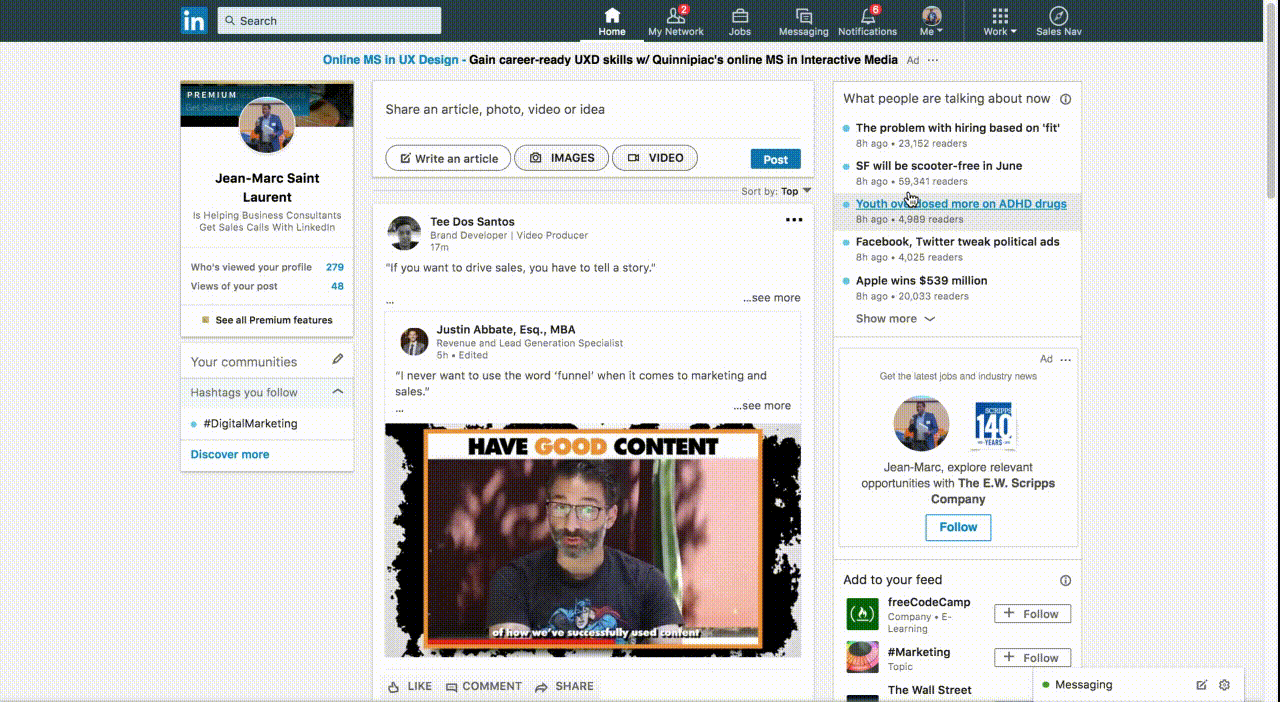
In the event you’re unsure how to start searching for people on LinkedIn, you can easily do so from any page of linkedin.com once you’re signed in.
Simply look to the top of the page to find the search bar and enter in your preferred term. LinkedIn’s search bar recognizes three different types of things: jobs, people, and companies. Any search you do will likely feature results from each of these categories.
That means if you search for the term “VP Marketing” or vice president of marketing, your search will yield current people in your network who have this title and open jobs for this title.
Searching first by the job title you’re looking to connect with is recommended because it will help you start finding your best VIPs and leads. This job title search will provide you with an initial list of people you can include or exclude via filter options.
LinkedIn Lead Generation: Searching Tips To Keep In Mind
- When searching for people on Linkedin, make sure you’ve clicked on the “people” in the top bar.
- Then you want to click on “2nd” for connections.These are going to be people with whom you share at least one connection.
- Make sure you have filtered by your local area
- Filter search results by industry type. For example, if you’re trying to get into industrial or manufacturing work, click on those industry types.
- Also, sometimes you may want to get in touch with folks that are at specific companies. In that case, click on the current companies filter and type in the name of that company.
- Don’t be scared away from connecting with folks that just may be a little bit higher than you were aiming for. As they say, aim for the moon and you just might hit an eagle. So don’t feel intimidated reaching out to folks a little bit higher up the food chain. You just may be surprised at what you get.
- While you might feel uncomfortable reaching out to new people on LinkedIn, remember that we’re all people, at the end of the day. We like to build relationships, meet helpful people and receive appreciation.
Import As Many Contact As Possible
Because I’m recommending you start searching for and connecting with your 2nd connections to start with, the assumption is that you have a decent amount of connections on LinkedIn.
What if that is not the case?
Never fear. You can always leverage your email contacts to grow your network exponentially.
It certainly worked for me.
At the time I was set on connecting with the right people via LinkedIn and discovered the potential power in 2nd connections, I also recognized my network was pretty puny.
So, when LinkedIn asked me about connecting with hundreds of potential connections it found from my email contacts, I said yes to most. Some hadn’t talked with me in years, some might have been holding some grudge against me, furthermore, there were others I barely knew and had only shared a phone and email conversation with.
Regardless, if I figured they was at least the chance of a “maybe” on connecting, I allowed the connection request to happen. And I was greatly surprised by the caliber and number of people who had chosen to connect.
LinkedIn offers you several chances to import email contacts if you are reasonably active on the site and actively connecting with others.
However, If you’d like LinkedIn to find out who you might know on the site via email contact search, click here: See who you might know on LinkedIn and Import contacts.
See you in the next module where we’ll talk about messaging.
*Just so you know, this post comes with a free worksheet to help you go from Setup to Sales Call with LinkedIn. Get the accompanying worksheet here.

by Jean-Marc Saint Laurent | Jun 14, 2018 | Using LinkedIn for Sales
We’re going to talk about LinkedIn Sales Leads Personas. It’s how you get a clear vision into who you have to connect with in order to make your dreams a reality.
Essentially, we’re doing all this LinkedIn stuff for one reason: to make our life situations better in some way. And the secret to an improved life has always been the right people. It’s people that help us grow, get promoted and generally move up.
I know this from experience. As I shared in the last post when I was living in a roach motel and needed to improve my life, getting around the right people is what made all the difference.
So–give yourself a pat on the back–getting clear on understanding the people you want to connect with, will help you tackle the hardest part of this process in advance.
Let’s talk about it.
*Just so you know, this post comes with a free worksheet to help you go from Setup to Sales Call with LinkedIn. Get the accompanying worksheet here.
Understanding Your Ideal LinkedIn Sales Leads or Potential Customers
Answering the following questions will help you understand your best VIP or Lead, for the purpose for connecting on LinkedIn and beyond.
Remember, not all questions will matter for every person or business. Answer those that are most relevant for your situation and target market.
Another point: The purpose of answering these questions is to develop the best generalization of your target person possible. As Google Primer recently put it,
Personas are fictional profiles that represent groups of similar people in a target audience. They can help you figure out how to reach people on a more personal level, while delivering the right messages, offers, and products at the right time.
Demographics?
Is this person college-educated? Are they typically experienced in the role? How many years have they had in their role? Are they typically married? Are they typically single? And what sort of companies do they tend to work for?
Mannerism And Buzzwords?
What sort of personal quirks and qualities set them apart? Are there certain kinds of conversations they’ll regularly engage in? Are these people typically cynical? Do they like dressing up or dressing down for meetings?
Job Title And Seniority Level?
Depending on your individual goals for connecting, you’ll be targeting different sorts of people.
In my work, I’m sticking to the following levels: CXO or C-Level Execs, VP or Vice Presidents, and Directors. Directors, by the way, are traditionally the best group to target, driving up to 70 percent of LinkedIn deals.
Directors are also going to be your best bet for finding an “in” at any company because they are generally easier to reach than a vice president or C-level executive (CMO, CEO, etc.), however they still hold decision-making power.
Ask, “Which role oversees the sorts of work I’d like to do?”
Business Goals?
Last year, I’d worked with a video marketer who believed his greatest point of differentiation was understanding the business goals of marketing executives, his target customers. In his mind, other businesses in the video service world showed a lack of understanding when it came to customer business goals by
-Failing to…
-listen,
-express experience worth trusting
-understand a marketing department’s vision
-see themselves as a piece of a larger marketing strategy
Avoid this pitfall by writing up a few business goals your target lead has in mind. If you can, draw up their possible primary and secondary business goals.
What Do They Most Value About The Product/ Service You Offer/ Work You Do?
Another way to come at this is to ask how you help your desired VIP or lead.
What Experience Are They Looking For When Deciding To Buy Your Product?
Remember that similar products for similar uses might demand different buying experiences depending on the target customer.
For example, while individual marketers are accustomed to purchasing software online directly from the pricing table on a website, without talking to a single salesperson; a Director of Marketing at a large company purchasing software tends to expect a phone conversation with a salesperson in order to get a specific demo and quote reflecting her department’s needs.
Having Difficulty Answering These Questions?
The easiest way to get answers to these questions is to start connecting with these people. There are simple ways you can do that. You can try and call these people up on the phone, God forbid, and you can reach out via LinkedIn (as I’m helping you do). You might also check out forums that these people tend to frequent.
Just make sure you have something to go off of. You don’t want your imagination serving as 100 percent of your source material.
After The LinkedIn Sales Leads Persona: Creating A Journey And Empathy Map
The greatest asset one has in pursuing any endeavor is their time. And the best way to ensure your time is best used is to make a direct link between your social selling and your typical sales process.
So, what does your ideal customer’s journey look like?
Creating A Journey Map
This does not have to be complicated in the slightest. All you need to do here is create a numbered list of how a person typically learns and eventually chooses to buy your product.
Here’s an example, seeing how Isabella, the Director of Marketing for a large company comes to finally buy marketing software for her department:
Creating An Empathy Map
To create an empathy map, take the marketing persona you have created and place them in a hypothetical, yet common situation. Doing this, will help make the difference between an OK time and a remarkable purchase experience with your company. This is where great reviews come from: empathy.
Once you have this common situation or problem that your persona goes through, think up how you or your business might resolve this issue
Google Primer shares the following example for a fictitious pizzeria by a university:
Situation: “Alice needs to quickly and easily order 15 sandwiches and several side dishes because she and her classmates are studying for an incredibly important test.”
Resolution: “‘All Night Cram Special’—a bulk package of sandwiches and sides that busy and stressed study groups can order with one click.”
*Just so you know, this post comes with a free worksheet to help you go from Setup to Sales Call with LinkedIn. Get the accompanying worksheet here.

by Jean-Marc Saint Laurent | Jun 2, 2018 | LinkedIn Lead Generation, Using LinkedIn for Sales
In this post, our focus is going to be LinkedIn sales prospecting. Prospecting is what allows us to find the right people to connect with. Because we don’t want to connect with just anyone. We want to connect with those that can help us–and that we can help in return.
*Just so you know, this post comes with a free worksheet to help you go from Setup to Sales Call with LinkedIn. Get the accompanying worksheet here.
Before we start sending connection requests to some of the half-billion users on LinkedIn, we’ll want to get clear on our goals and intentions, as far as this social activity goes.
Why is it important that we have goals for our LinkedIn connections?
“I want sales so what’s the problem?” You might be thinking to yourself. Yes, but social selling does complicate that a bit, as various people and prospects have told me on several occasions: I’m only LinkedIn for networking.
I can tell you from my personal experience that being unclear on my goals is something that’s impeded my own expansion in the past.
In the beginning, when I started connecting with folks on LinkedIn–first, I didn’t know it was going to work and second, I really didn’t know why I was reaching out, outside of a general sense of desperation. I was just stuck in a roach hotel in a new city, the city of Denver, without any connections or direction. I had applied to over 425 different positions with no results.
It was ridiculous.
But as I began to develop success with my LinkedIn connecting abilities and actually got important people in marketing to sit down with me, I regularly felt dumbfounded as to what I should do next.
I want to help you skip those issues. So let’s get into how you can set your goals and intentions correctly for connecting with folks on LinkedIn.
LinkedIn Sales Prospecting: Developing Goals and Intentions For LinkedIn
What Impact Do I Want To Make?
Think of setting up your whole LinkedIn journey as putting in a destination into your GPS. When you’re driving in your car, you don’t just get in your car hoping you’ll get someplace, right? You set your GPS and you say, ‘I want to go to this restaurant,’ or ‘I want to go visit my friend in the city.’ You set your destination.
In the same way, you want an end goal for the connections you’re seeking to make on LinkedIn.
For the sake of full disclosure, I had originally written this question down as “how much do I want to make?” but then wiser heads helped me realize money isn’t what really motivates any of us. None of us wants money for money’s sake. Instead we seek some sort of outcome.
For you, this might look like Significance, which might translate to…
“I want to work with the world’s top business coaches because I believe I can make the biggest impact being surrounded by that level of excellence and ambition.”
Maybe you believe you can impact the most people by Being the Best Giver, which might translate to…
“I want to work as a successful freelance data scientist for national nonprofits so that I can help organizations that give so much maximize their own impact by making sense of their numbers.”
Then again, perhaps your focus is Security and you believe you could make the greatest impact inside of a well-funded legacy institution. This might translate to…
“I want to work as a virtual Co-CFO for large companies that may need the support so that I may provide for my own team, stakeholders, and family.”
Once you’re able to articulate this and write it down, don’t be surprised if potential opportunities and people you should meet pop into your head. Once they do, we can think about….
What is my purpose for connecting?
Like I mentioned earlier, when I started connecting with people on LinkedIn, I was lost as to my purpose.
This only served to waste the time of people with whom I sought to connect. And as the great writer/poet/diplomat Dante Algheri put it:
I actually ended up going into a coffee meeting with a well-to-do marketing agency founder clueless. This guy was well-connected and was the president of one of the top marketing associations in the area.
I had gone to a bit of trouble in order to impress him, bought a pink box of famous Voodoo Donuts, drove over an hour and a half so he wouldn’t be inconvenienced,and wore my smartest sport coat.
However, when he looked straight at me and asked, with a bit of irritation in his voice, “What do you want? Why are we meeting?” I didn’t look so smart.
This guy was irritated with me because I was there, good-looking as I was, wasting his time.
So, answer, what do you want?
Some possible answers that might resonate with you,
My purpose for connecting is to…
- see if this person might want my product/service.
- do some market research.
- see if this person can introduce me to possible customers.
- learn about potential work/business opportunities in their industry.
How might I help them?
While you likely have some burning need in the back of your mind at any given moment pushing you to reach out and connect with new people, don’t forget that each of these people has their own pressing needs. Think about how you might help them.
2 Easy Ways To Help:
Listen. Just honestly listen. None of us feels over-appreciated in our lives. Your listening to any given individual may be the greatest gift they’ll receive all quarter. They may not have anyone else to talk to. Sounds like a stretch? Remember, Linked recently shared,
Nearly half of respondents to a nationwide survey by health insurer Cigna say they always or sometimes feel alone, and 54% say they feel no one knows them well.
Another simple and straightforward way to help others is to open up your rolodex. Make helpful connections on their behalf. Recommend people, groups, and resources that might help or solve issues they’re struggling with.
This allows you to be at a little higher frequency when you’re connecting with people. We’ve all connected with people that just want something from us or wanted to see what they could get for nothing, and that’s not the kind of frequency you want to be at.
We want to make valuable connections that last.
In our next post, we’re going to cover VIP (or lead) Personas. In a previous post, we touched a little bit on determining needs through keyword research but in the next post, we’ll cover understanding this ideal VIP/Lead in-depth. I promise it will help ease connecting with VIPs and leads. See you then.
*Just so you know, this post comes with a free worksheet to help you go from Setup to Sales Call with LinkedIn. Get the accompanying worksheet here.

by Jean-Marc Saint Laurent | May 30, 2018 | LinkedIn Lead Generation, Using LinkedIn for Sales
“I have followers on LinkedIn, but how do I start using LinkedIn for Sales?”
I hear it regularly enough to foretell this is exactly what I will hear the minute I tell people that “I help businesses get sales calls with LinkedIn.”
It’s like LinkedIn is a secret language that few speak. It doesn’t need to be. I’m here to explain this language succinctly.
But first, a step back. Why is LinkedIn or social selling important anyway?
A Few Helpful Facts About Using LinkedIn For Sales and Social Selling
According to Business 2 Community,
74% of salespeople who beat their 2014 quota by 10% or more say they have an excellent understanding about the use of social media for prospecting, nurturing relationships and closing deals. They were over 6x as likely to exceed their quota than sales peers with rudimentary or no social media skills. (Forbes)
Also, LinkedIn reports,
Customers who use LinkedIn Sales Navigator see 35%+ larger deal sizes.
50 percent of B2B buyers use LinkedIn as a source for making purchase decisions.
76 percent of B2B buyers prefer to work with recommendations from their professional network.
In fact, 90 percent of C-level executives say they never reply to cold calls or cold emails.
Leveraging LinkedIn Is Like Throwing A Party
When thinking about how you can get started leveraging your presence on LinkedIn for business, realize it’s like throwing a party. You just follow the same steps:
- Prepare your home for visitors
- Build your list of people to invite
- Invite people and reach out
1. Prepare Your Home for Visitors
On LinkedIn, your basic home is going to be your profile page. Make sure it’s prepared for people to visit it. Main places to focus on include your…
- Banner and Profile Picture
- Keywords
- Profile Summary
- Jobs and Accomplishments
Your Banner and Profile Picture
The quickest and most fun way to create your LinkedIn profile is to use Canva. It’s a pretty free service that allows you to design the multitude of things you will need to create during your business and career lifetime.
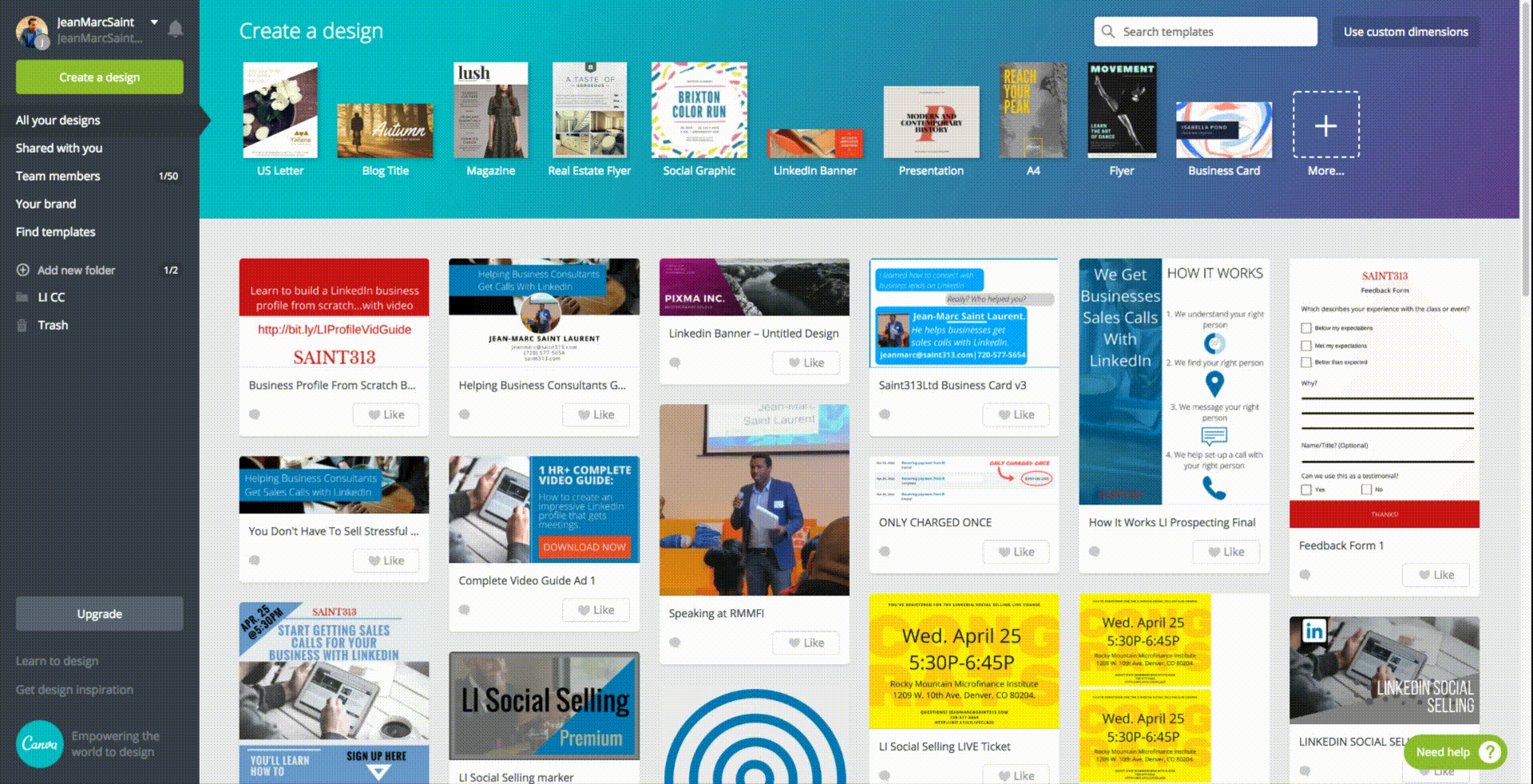
Creating a banner: the steps
- Go to https://www.canva.com/.
- Create an account or Login (if you have an account already).
- Once logged in, type “LinkedIn” In the top search bar.
- Click on “LinkedIn Banner.” That will take you to a blank workspace.
- On the left side of the workspace, click on your preferred template.
- Change pictures, colors and text as you see fit.
- Recommendation: include a simple phrase or a few key bullet points that explain what you do. Doing keyword research will help.
- Once you’re done with your banner, click download in the upper right hand corner.
- Choose your format. PNG is best for pictures and text in this situation.

Producing a Professional Profile Picture
I talk about this in detail in a post about setting up a professional LinkedIn profile picture.
That said, here are a few immediate tips:
- Stay away from wide angle lens shots.
- If using a smartphone, make sure the phone camera has a large aperture.
- One of the worst things you can do: taking a picture in front of a plain white background.
- Facial expressions matter. I would suggest you get used to smiling in your pictures.
2. Build Your List of People to Invite
It’s important to ask who you’d like to be at your “event.” You probably aren’t inviting your business contacts to a rager and you probably aren’t inviting your drinking and clubbing buddies to an intimate business talk.
In the same way, you want to be selective about the kind of people who you’re trying to reach on LinkedIn. In marketing, we typically create a profile for this purpose and call it a persona.
While the effectiveness of marketing personas has been up for debate recently, Google just put out an empathetic guide on creating effective personas. So, if Google says it’s still relevant, it must be relevant.
The people you target for invitation or outreach is going to depend upon your goal. What is it?
Do you want to…
Let current contacts know about a change in your business?
Build your network in-person over a cup of coffee?
Invite new potential clients to a webinar?
Mine current connections and past clients for referrals?
Let people of a certain industry and location know about your upcoming event?
Building Your List of Potential Connections With LinkedIn
- Using LinkedIn’s search bar, search the title of the specific person you want to invite or reach out to. Some examples might be “project manager” or “vice president of marketing”
- When the search results appear add the following filters, depending upon your goals:
- 2nd connection: if you want to reach new people OR
- 1st connection: if you want to reach people who are already connected with you
- Location: add in your desired location if that matters or is consistent with your goals. *This would matter if you want to invite people out to coffee.
- Seniority: if you want decision-makers for business purposes, target C-Level Executives (CMO, CEO, etc.), Directors (best group to target), and Vice Presidents
- Company size: if you want mid-size businesses, aim for those under 10,000 employees. If you want small businesses, stick with businesses that have under 500 employees.
3. Invite People And Reach Out
Notice: This is where you will want to read LinkedIn’s User Agreement and compare it with its Terms of Use for Developers then come to a conclusion as to what it means for you.
At first, it seemed to me as though, LinkedIn didn’t want anyone to use any tools of any kind to get stuff done. However, reviewing the terms for developers has made this view more gray and less black-and-white in my opinion.
Personally, I’m currently going through the painstaking process of typing everything. Ugh!
I have been looking at some tools though, and here are the best I’ve found for inviting people to connect and doing outreach via LinkedIn aimed at your current connections:
LinkedIn Helper for the Chrome Browser
Dux-Soup for the Chrome Browser
Leonard for LinkedIn (Install and Download for Chrome)
Regardless of the app you decide to use, they will each do a few key things:
- Mass Endorsement of Profiles
- Auto Profile Visits
- Mass Personalized Invitations
- Auto-Respond to New Connections
- Mass Messaging to Connections
My main issue with these tools is that I can tell when someone has used them to ask for a connection or send a message my way.
Adding someone’s first name to a message is not new magic and hardly meets the standard of human communication these days. One of the things that I believe makes my own services effective is the ability to interact with the fragile details of a decision-maker’s profile.
If I tried to use one of these auto tools to do what I do, I’m pretty sure I would offend most and get ignored by the rest. However, someone using a different spray strategy might crush it with these same tools.
Final Note: Diversify From LinkedIn
When working with salespeople I’m helping get sales calls with LinkedIn, guess what? I don’t always deliver…right away. Sometimes people will be interested and responsive via LinkedIn and sometimes they won’t.
I don’t like depending on the mood of the day, so I enlist another tool as backup.
It’s called Adapt (formerly Saleslift) and it’s also available on the website-level and as a Chrome app (what can I say, Chrome makes awesome tools–that’s why I made the switch).
The tool allows you to follow up with leads via email and phone by connecting LinkedIn profiles to company profiles. And this way you aren’t at the mercy of one tool but have an arsenal to assist you.




